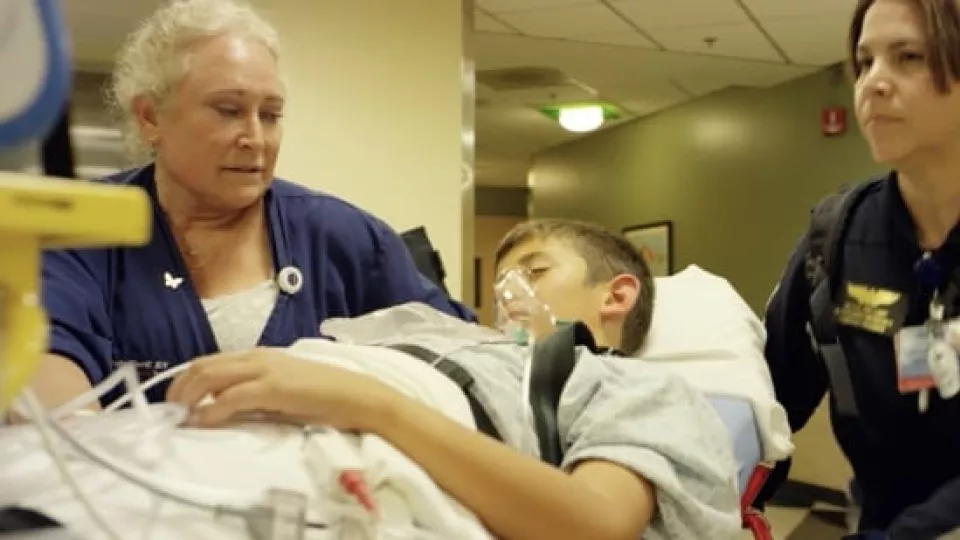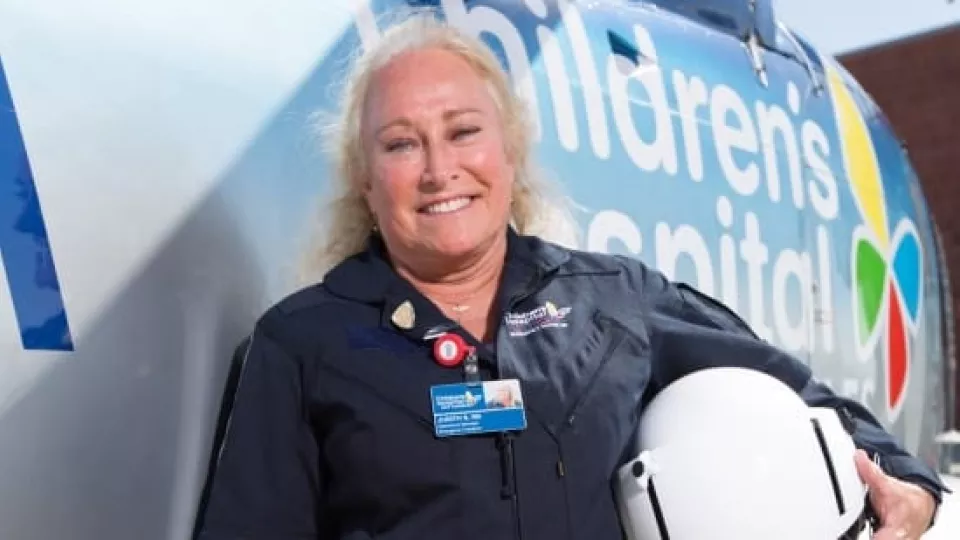
RN AIR
Once upon a time, there was a little girl named Judy. She wanted to be a nurse when she grew up. Judy took auto shop class. Judy worked on a pit crew. And Judy flew airplanes.
[Cue the record scratch.] Wait a minute, that’s not how the story usually goes.
Judy Sherif, RN, is not your average storybook heroine. For starters, she’s known exactly what she wanted to do since she was a small child.
“I’ve always wanted to take care of children,” she says. “When I look at my little school folder that my mom kept, every year it said, “When I grow up I want to be … a mom and a nurse.”
Driven
From there, it gets more interesting. In high school, she joined the pit crew for her drag-racing brother-in-law.
“I loved it. I loved wearing my overalls, and having a ratchet wrench to take the spark plugs out,” says Sherif. “It was high-paced; you needed to do it quickly; you needed to do it accurately so it wouldn’t misfire; I loved it. I think it’s that adrenaline rush that I need, I guess.”
Her pit crew experience led her to auto shop class in high school, where she was not exactly welcomed with open arms.

“When I showed up the first day, the auto shop teacher was like, ‘What are you doing here?’ It was a battle from the beginning just to be allowed to take auto shop.”
So she gave up and went home. (Just kidding.) She showed up and proved him wrong instead.
Sherif also pulled 3-to-11:30 p.m. shifts as a nursing assistant at the hospital after finishing her high school classes for the day, and earned her nursing degree when she was just 18 years old. And soon, she started flying.
“I would fly to the Indian reservations, to pick up children for the Indian hospital that we had in Phoenix. It just so happened that the person who flew the aircraft was an instructor,” says Sherif. “So he gave me flying lessons when we were en route to get the patients, and that’s how I got my pilot’s license.”
“Flight was intriguing to me..." At the time, she wondered, “Why aren’t women doing this? It’s amazing.”
“Flight was intriguing to me. There weren’t a lot of women flying at that time,” she says. At the time, she wondered, “Why aren’t women doing this? It’s amazing.”
Judy loved working in pediatrics, but really wanted to be a part of a hospital completely devoted to children. She made the move to Children’s Hospital Los Angeles in 1983, where she started out in the Emergency Department. In 1998, she took over management of the hospital’s Emergency Transport Program.
It isn’t broken, but it could still be better
Sherif identified a key area of improvement in her initial assessment of the program she was to run. The hospital contracted air transport services from an outside aviation company. This meant that if CHLA needed a helicopter and the company was already on a flight mission, the hospital was out of luck. Helicopters could even be diverted at the last minute for trauma flights, calling to cancel when the transport team was already waiting on the helipad.
“This is problematic. If we can’t fly, we could have been already on the road driving,” she thought. She appealed to the hospital’s CEO, but a dedicated helicopter and the accompanying expenses just weren’t feasible at the time. So, she found another way.
Safety first
In her personal time, Sherif flies out of Van Nuys Airport, and is tied down (that’s pilot speak for parked) not too far from Helinet Aviation. After doing some safety research with the Federal Aviation Administration—the company’s safety record was far better than the one the hospital was already contracted with—she marched into owner Alan Purwin’s office, and asked him if he’d give her a dedicated helicopter. And pilots. And fuel. And maintenance.
“I told him what I wanted, what the program was all about; that the hospital couldn’t afford a flight program, but it was really important,” says Sherif. “The very day that I went in there to talk to him, he said, ‘Yes, I absolutely want to do this.’”

The word you are looking for is “moxie.”
Judy put strict rules into place to ensure the safety of her team. (She talks about safety more than you’d expect from an adrenaline junkie.) Though some team members were initially resistant to the change, they quickly realized it was a far better system than the one CHLA had been used to. She takes great pride in what she calls CHLA’s “critical care unit on wings or wheels”—now one of the largest emergency transport programs in the nation—which offers complex medical care on the move. “We can take that level of care to other hospitals that don’t have these resources.”
In her off time, she flies a Piper Archer airplane. She and her daughter Natalie, now grown, used to do a “girls’ night out” every Friday night, flying to destinations like Las Vegas, Santa Barbara, Catalina Island or Phoenix. Judy is also a cancer survivor, and a scuba diver.
“I believe my scuba diving training is what taught me how to deal with fear,” she says. “Learning how to calm yourself when faced with fear is critical; panic only makes the situation worse, so you need to take a few seconds—sometimes that’s all you have—to tell yourself to ‘calm down, relax, I’ve got this.’”
Yes, Judy, I think it’s clear—you’ve got this.


